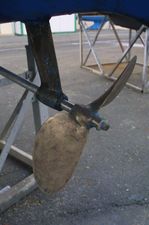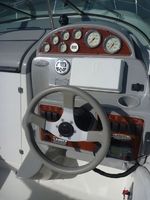Motor
-
See advice
How does it work?
A bow thruster consists of a propeller installed below the waterline close to the bow. Driven by a powerful electric motor, the propeller, operated from the helm, often by a joystick, direct the bow left or right. Working in connection with the main engine, the bow thrusters facilitates port manoeuvres. To be effective the propeller of the thrusters must be placed as far forward as possible (to provide the best leverage) but sufficiently submerged to ensure propulsion and not simply disturb the air. This is the paradox because on sailing vessels as on motor launches, the forward section of the hull is often low to the water. The positioning of the propeller is thus, a compromise. Certain models of thrusters may be installed to the rear of the boat. These are called the stern thrusters. Bow and stern thrusters combined can move the boat laterally. -
See advice
+There are a multitude of out-board propellers. They are classified according to diameter and function.
+To each boat its propeller. The models vary depending on the hull, function, weight and engine power. The motor mounting (in height,) may also require a change of propeller.
+Ensure the right propeller in accordance to manufacturer’s advice.
-A propeller which is too long (not too large,) demands too much power and prevents the motors correct acceleration.
-A propeller which is too short (not too small,) will permit motor acceleration but without corresponding optimal boat speed.
-
See advice
The entanglement of a rope around a propeller shaft is one of the most serious situations with which one may be confronted at sea. It may even cause the sinking of your vessel. The rope cutter is the simple answer to this risk: a blade fixed around the shaft systematically cuts rope, or seaweed that might otherwise ensnare the propeller. Among the products on the market AD has chosen one-piece 316 L stainless steel models, which act by slicing and not by shear. The shear models contain a fixed and movable part. We consider them more dangerous because they run the risk of getting stuck when they meet a cable with too large adiameter, and may thus block or damage the propeller shaft.
-
See advice
This seal assures waterproofing at the propeller shaft (a turning shaft.)Progress in industrial materials has enabled the development of new turning joint systems for the shaft. The principle is simple: two rings with a polished surface (a stainless steel and a graphite ring)rub against one another. One ring is attached to the propeller shaft with which it turns, the other is attached to the stern tube by neoprene, this ensures a constant pressure. The sea water acts as a lubricator for the two rings. It is therefore important that the stern tube is always full of water. For fast boats, on which the stern tube empties due to the vessel speed, there are models with water injection (ask us.)The rotary joint frees you from all the
maintenance problems associated with conventional systems (water in the bilge, retightening, setting it so tight it damages the shaft…)Ensure there is water present in the valve by simply loosening it slightly. Although it does require maintenance,one should c -
See advice
The tachometers selected by AD fit easily on all motors. On the battery/coil device for petrol motors and on the alternators equipped with a, “W” or, “R” terminal. Their waterproof face and their lighting (optional,) permit their installation on external consoles. They are protected against polarity reversal and have a precision of plus or minus 2%.


